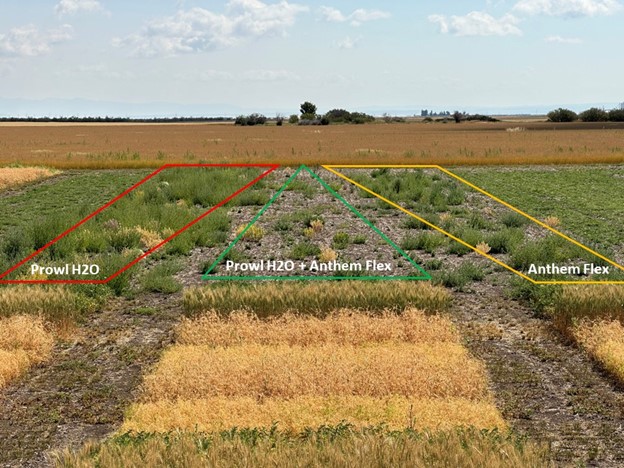Residual Herbicides for Control of Kochia
Table 1. Yield (lb ac-1) of weed biomass in fallow plots and seed yield of spring wheat, pea, lentil, and chickpea (lb ac-1) after a single application of Prowl H2O in fall, a single application of Anthem Flex in spring, or both (Anthem Flex + Prowl H2O). A single application of Anthem Flex in spring resulted in weed control superior to fall-applied Prowl H2O and equivalent to Anthem Flex + Prowl H2O in fallow plots. No seed yield differences among treatments were detected for any crop.
|
Treatment |
Weed Biomass |
Wheat |
Pea |
Lentil |
Chickpea |
|
Prowl H2O |
4356.0 |
1913 |
1254 |
1204 |
501.0 |
|
Anthem Flex |
982.5 |
1781 |
1335 |
1120 |
668.5 |
|
Anthem Flex + Prowl H2O |
389.0* |
1434 |
1403 |
1203 |
588.5 |
|
Average |
1909 |
1710 |
1331 |
1175 |
586.0 |
|
CV% |
20.09 |
17.80 |
6.403 |
10.64 |
17.34 |
|
LSD |
663.7 |
NS |
NS |
NS |
NS |
|
P-Value |
<0.001 |
0.252 |
0.218 |
0.668 |
0.424 |
Bold* = top performer within a column; Bold = equivalent to top performer within a column; NS = Not significant

Figure 1. Plots harvested for seed yield (foreground) with fallow plots harvested for weed biomass (background) at the Central Agricultural Research Center near Moccasin, MT. Residual herbicide treatments are indicated. Kochia dominated weed profiles of all treatments (>61% of total plants), but pressure varied greatly among treatments (see Table 1). Despite visibly greater kochia pressure in the Anthem Flex fallow plot, statistical differences between this treatment and the Prowl H2O + Anthem Flex treatment were not detected. However, both treatments controlled kochia better than the spring-applied Prowl H2O treatment alone.

